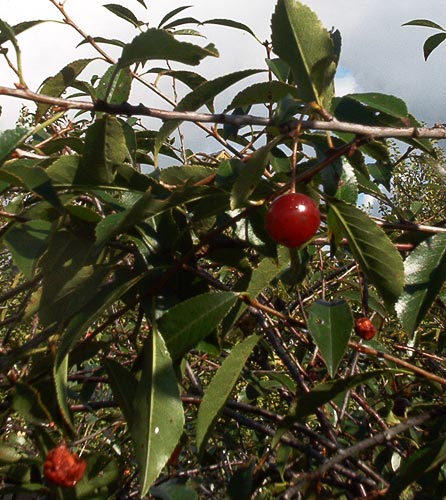Crops
Prunus cerasus L. - Common cherry.
Synonyms.
Cerasus vulgaris Mill., Cerasus collina Lej. & Courtois, Prunus cerasus L. var. typica C. K. SchneiderCherry tree, Sour cherry.
Taxonomic position.
Family Rosaceae Juss., genus Cerasus HillMorphology and biology.
2n=32Tree or shrub up to 7 m heght. Crown is oval, roundish or weeping. Leaves oval, till 7 cm length, tilll 5 cm width, with crenate-dentate edge, acuminate, with glandulosus in basis, with leafstalk 1-2 cm length. Flower about 25 mm diameter, with 5 white petals, one pestil, 20-30 stamens. Peduncule 30 mm and more. 2-4 flowers combined in inflorescence - umbel. Fruit - drupe with juicy pericarp, diameter till 1.5 cm. Fruits divided by size: small - up to 3 g, middle -3.1-4.5 g, large - more than 4.5 g. Shape can be spherical, flat-spherical, wide-spherical ect. There are two sort groups: griot - with deep-red peel and red juice, and amorel - with light-red peel and week-coloured or achromatic juice.There are more than 100 sorts on the territory of the former USSR. The most common sorts: Amorel rozovaja, Vladimirskaja, Griot ostgeimskaja, Izobil.naja, Liubskaja, Malinovka, Ural.skaja rubinovaja, Zhedraja.
Distribution.
Wild kind is not found. It is natural hybrid of sweet-cherry and steppe cherry happened in Macedonia or, probably, in Northern Caucasus and Ukraine. In Russia cultivated beginning at 15 century. Area on the territory of the former USSR comes to 60° of northern latitude. Major plantations are in Moscow, Vladimir, Kursk, Belgorod, Har.kov, Samara and others regions. Cultivated in Transcaucasia and Middle Asia States also. There are creeped forms of cherry in steppe zone of Western Siberia.Ecology.
Relatively cold-resistant. Does not bear winters with long-term decrease of temperature below minus 35-40°C, friquent alternation of thaws and frosts, recurrent cold weather in spring. It is necessary sum of active temperatures for early-ripenning sorts 1400°C, and for late-ripenning sorts 2000°C. Photophilous. Prefers light, structural, fertile, moisture-capacious, well-airing soil with neutral pH (6-7); with ground water on the deep more than 1.5 m. Drought-resistant enough. Planting not less than 2-3 sorts in a garden for cross-pollination.Economic value.
Main stone-fruit plant. Fruits contain 6.9-17.5% sugars, 0.76-3.0% acids, 9.5-35.6 mg/100 g ascorbic acid, vitamines B1, B2, B9, K1, E, carotin, pectines, P-active substances, tannin. Fruits used as fresh, as dry and frozen kind. Produce jam, compot, jelly, juice, vine, nalivka. Fruits, pedicles, branches, gum used as officinal stuff.Seeds contain 25-35% fatty oils. Spirit, glue, essential oil are produced from stones. Leaves used for solting and pickling of mushrooms and vegetables, for jam berries. Good honey plant. Ornamental plant. Wood is suitable for turner.s and joiners goods. Life duration of trees 12-15 years on the North-west and 25 years and more on the South. Bear fruits on 2-3 years after planting. Productivity 6-12 (80) kg per tree, 10-20 ton per hectare. Propagated by grafts, root offshoots, cuttings.Literature.
Barsukov N.I., Suhatskaja S.G. Cherry in Western Siberia. Omsk, 1984. 70 p.Kolesnikova A.F., Kolesnikov A.I., Muhanin V.G. Cherry. Moscow: Agropromizdat, 1986. 240 p.
Miheev A.M., Reviakina N.T. Cherry. Moscow: Agropromizdat, 1987. 39 p.
Vehov V.N., Gubanov I.A., Lebedeva G.F. Cultural plants of the USSR. Moscow: Mysl', 1978. 336 p.
Vitkovsky V.L. Fruit Plants of the World. St. Petersburg-Moscow-Krasnodar. Lan'. 2003. 592 p.
Yushev A.A. Cherry. St. Petersburg: Agropromizdat, Diamant, 2001. 206 p.
Zhukovskii P.M. Cultural Plants and their Relatives. Leningrad: Kolos, 1971. 751 p.


